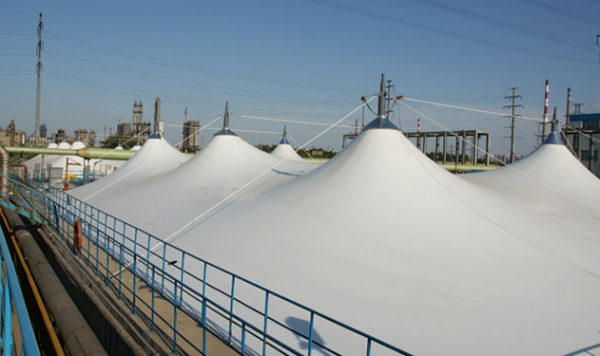The anti-hanging membrane structure is very convenient to install and the construction period is short. The effect of waste gas treatment has also been recognized by the owner. The material used in the anti-hanging membrane structure is generally based on membrane materials.
The anti-hanging membrane structure is very convenient to install and the construction period is short. The effect of waste gas treatment has also been recognized by the owner. The material used in the anti-hanging membrane structure is generally based on membrane materials. So do you know how the anti-hanging film manufacturer transports the film to the construction site? What preparations need to be done in the early stage?

Before the construction of the reverse-hanging membrane project of the sewage pond, the sewage pond needs to be subjected to relevant pond body measurement and related membrane material measurement. Due to the cleanliness requirements of the membrane material, the membrane material needs to be cut at the manufacturer. Then packed and shipped to the scene.
When transporting the membrane material of the sewage tank, try to divide the cover into small pieces for transportation. This not only facilitates disassembly and manual handling, but also saves the cost of calling large equipment. After each membrane plate is transported in place, during splicing installation, the small pieces of membrane material, between the membrane material and the top surface of the pool, need to be sealed and connected, which can effectively prevent odor leakage. After we finish the splicing and installation, we can first use water or air to replace the odor for debugging, check whether the installation result has reached the sealing effect, and check whether the cover plate has dripping, leaking, or leaking phenomena. After a series of inspections are completed, it can be used normally.
The inflatable membrane sports hall has a certain sound insulation effect, and its sound insulation performance can be further improved through design optimization.
Winter is here, and everyone wants to find a warm and comfortable place to exercise, right? The membrane sports arena is definitely a good choice!
In today's society where environmental protection is increasingly becoming a focus of attention, which company is good for covering sewage tanks with anti lifting membranes? How to choose a trustworthy partner among the many companies that provide sewage tank anti lifting membrane covering services? The following points provided by the Zhanji editor may be helpful for your decision-making.
When we use exhaust gas treatment equipment, we often overlook the maintenance and upkeep of the equipment.
Shanghai Zhanji Fabric Structure Co., Ltd. is a professional membrane structure vendor who has an expert engineering design and construction team, and are at the leading position in this membrane field all over China.